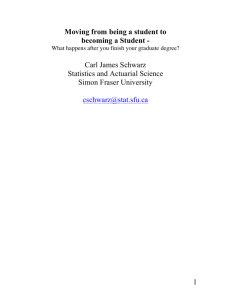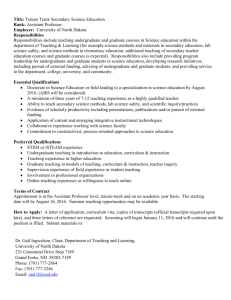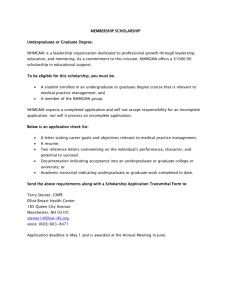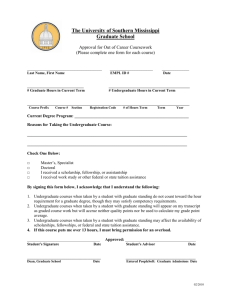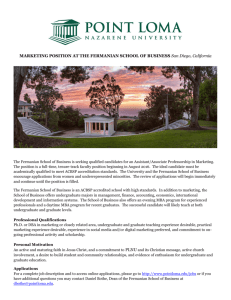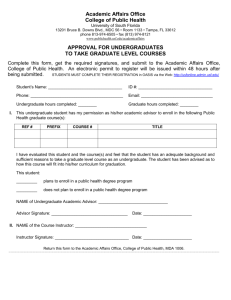Interview with Alan Agresti - Department of Statistics
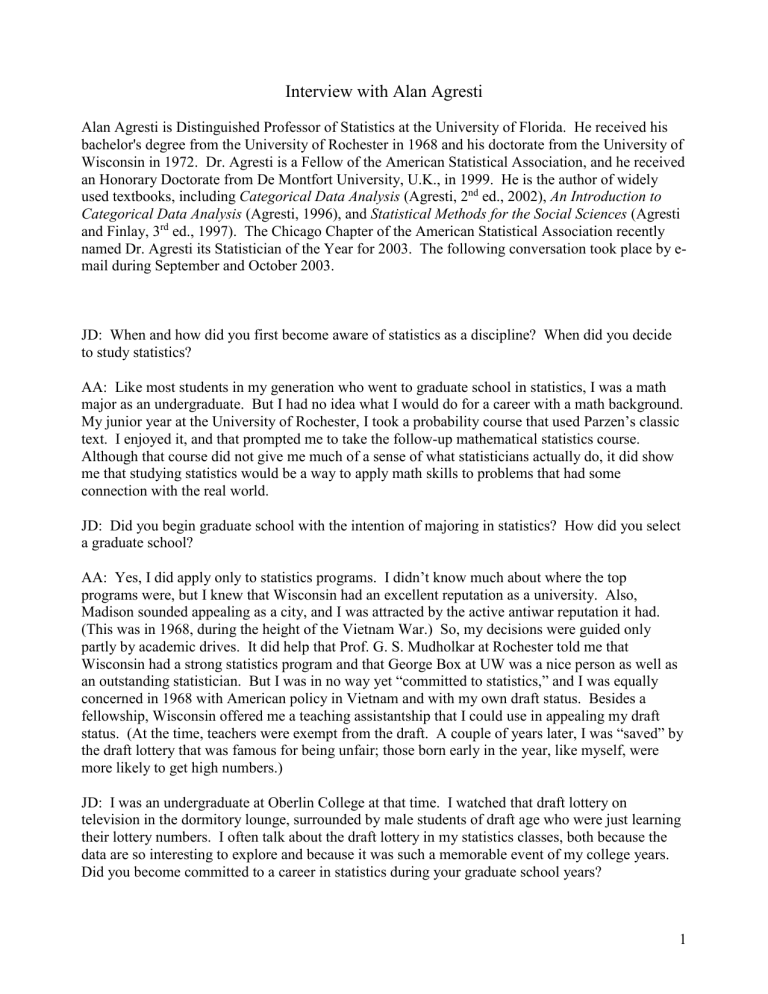
Interview with Alan Agresti
Alan Agresti is Distinguished Professor of Statistics at the University of Florida. He received his bachelor's degree from the University of Rochester in 1968 and his doctorate from the University of
Wisconsin in 1972. Dr. Agresti is a Fellow of the American Statistical Association, and he received an Honorary Doctorate from De Montfort University, U.K., in 1999. He is the author of widely used textbooks, including Categorical Data Analysis (Agresti, 2 nd
ed., 2002), An Introduction to
Categorical Data Analysis (Agresti, 1996), and Statistical Methods for the Social Sciences (Agresti and Finlay, 3 rd
ed., 1997). The Chicago Chapter of the American Statistical Association recently named Dr. Agresti its Statistician of the Year for 2003. The following conversation took place by email during September and October 2003.
JD: When and how did you first become aware of statistics as a discipline? When did you decide to study statistics?
AA: Like most students in my generation who went to graduate school in statistics, I was a math major as an undergraduate. But I had no idea what I would do for a career with a math background.
My junior year at the University of Rochester, I took a probability course that used Parzen’s classic text. I enjoyed it, and that prompted me to take the follow-up mathematical statistics course.
Although that course did not give me much of a sense of what statisticians actually do, it did show me that studying statistics would be a way to apply math skills to problems that had some connection with the real world.
JD: Did you begin graduate school with the intention of majoring in statistics? How did you select a graduate school?
AA: Yes, I did apply only to statistics programs. I didn’t know much about where the top programs were, but I knew that Wisconsin had an excellent reputation as a university. Also,
Madison sounded appealing as a city, and I was attracted by the active antiwar reputation it had.
(This was in 1968, during the height of the Vietnam War.) So, my decisions were guided only partly by academic drives. It did help that Prof. G. S. Mudholkar at Rochester told me that
Wisconsin had a strong statistics program and that George Box at UW was a nice person as well as an outstanding statistician. But I was in no way yet “committed to statistics,” and I was equally concerned in 1968 with American policy in Vietnam and with my own draft status. Besides a fellowship, Wisconsin offered me a teaching assistantship that I could use in appealing my draft status. (At the time, teachers were exempt from the draft. A couple of years later, I was “saved” by the draft lottery that was famous for being unfair; those born early in the year, like myself, were more likely to get high numbers.)
JD: I was an undergraduate at Oberlin College at that time. I watched that draft lottery on television in the dormitory lounge, surrounded by male students of draft age who were just learning their lottery numbers. I often talk about the draft lottery in my statistics classes, both because the data are so interesting to explore and because it was such a memorable event of my college years.
Did you become committed to a career in statistics during your graduate school years?
1
AA: Yes, I did, by the end of my four years. There were certainly many times in the first couple of years that I questioned it, such as whenever I attended a seminar and understood very little or was convinced that the field of statistics attracted more than its share of nerds.
JD: How and when did you decide on an academic career? Have you ever worked as a statistician outside academia?
AA: I made the decision after I got my master’s degree and decided to go on for a Ph.D. At first, I was nervous about the research pressures that come with a “publish or perish” job in academia.
Yet, I enjoyed my experience as a teaching assistant, and I really liked the freedom that comes with academia. I’ve always had a serious travel bug, so especially important to me was the opportunity
(with a 9-month contract) to take more time off in the summers than is possible in the U.S. with most jobs outside academia. My career has been restricted to academia, except for a summer job with the Census Bureau and many visits (one to three days) to various companies to present short courses.
JD: How do you feel now about that pressure to publish? You’ve obviously had a very successful research career; have you ever found the research pressure in academia to be excessive or oppressive?
AA: When I left school, the job I took in the Statistics Department at Florida put strong emphasis on good teaching. Research demands were there, but relatively modest. My position was created to develop statistics courses for students in the social sciences. From working with students and their advisors, I soon realized the social sciences had lots of categorical data. I got interested and changed my research focus completely from the area (branching processes) on which I wrote my
Ph.D. thesis to categorical data analysis. Such a change would have been difficult in a university that demanded greater research productivity than Florida did in those days. So, in answer to your question, I was lucky to start my career and develop my research skills in an environment in which the pressure was not excessive.
JD: Do you think that junior faculty members starting out today are under more pressure to publish and to get grants than we were 25 or 30 years ago?
AA: They certainly are. But I think there’s nothing special about academia in this respect. Job demands and uncertainties are higher throughout the workplace, particularly in the U.S. There is less pressure in academia in other countries, although in many it seems to be increasing and becoming more like the U.S.
JD: I find it intriguing that your interactions with students and faculty in the social sciences led to a shift in your research area. Can you elaborate about how you learned a new area and how you were able to identify interesting research problems in that area?
AA: Well, I soon found out that Leo Goodman was “God” to quantitative social scientists.
Goodman, a statistician then at the University of Chicago, has been the most prolific researcher over the past 50 years in categorical data analysis. For each article he wrote in a statistics journal, he wrote one on the same topic but at a more applied level for a social science journal. This is not a bad model for statisticians to emulate! So, I spent a lot of time reading his articles. It took a few years, but gradually I got a sense of the state-of-the-art research by him and by others who worked
2
in this area, such as Gary Koch and Steve Fienberg. I also learned a lot from the 1975 classic text
Discrete Multivariate Analysis by Yvonne Bishop, Steve Fienberg, and Paul Holland, which gives an elegant presentation of loglinear models for contingency tables. My own research was often motivated by questions I got while interacting with colleagues at Florida, such as “I know about
Fisher’s exact test for 2
2 tables. What can be done with this table that has more than two categories and which are ordered?” Overall, my research was helped by working in a still relatively undeveloped area and mainly on real rather than artificial problems.
JD: I’m interested in how your teaching, consulting, and research have motivated and influenced each other. You’ve said that working with students and faculty from the social sciences piqued your interest in categorical data. Do you continue to get research ideas from statistical consulting?
AA: Yes, occasionally. In fact, I’m currently working on a paper in response to a question I’ve received twice recently while visiting pharmaceutical companies. In magazine advertisements for new drugs, you’ll often see summary tables that compare the relative frequency of each of several adverse side effects for the drug and for a placebo, based on results from placebo-controlled clinical trials. How can one conduct a global test of equality of the vector of population proportions for the drug and the vector of population proportions for the placebo? For multivariate normal responses,
Hotelling’s T
2
tests equality of two vectors of means. For multivariate binary data, there are many possible answers to the question, but none is entirely satisfactory. Methods can be computationally intensive or asymptotic inference can be inadequate when each vector has a large number of elements, because of data sparseness.
JD: Do you incorporate the results of your research into your teaching and consulting?
AA: I try to. Even in teaching elementary courses, I try to give students some historical perspective and explain to them that statistics, like any field, is continually evolving. I always mention a few important modern advances, such as the bootstrap, but once or twice I’ll try to briefly say a bit about what I do or have done in statistics research. Students are surprised that you can do research in statistics. They imagine that we teach a toolbag of methods that have been in existence for hundreds of years. Sometimes teaching can even itself inspire research. Six years ago I started some work on binomial confidence intervals after wondering about the sample size guidelines for the simple confidence interval for a proportion that we teach in every basic statistics course.
JD: I know you’ve shown that adding two successes and two failures to the sample before calculating the usual Wald confidence interval for a proportion yields coverage probabilities that are closer to the nominal confidence levels than those of the unadjusted Wald interval. Do you now teach that method in your introductory courses? Will you include that method in the introductory text you’re currently writing? This seems like a perfect example of a recent research result that is simple enough to teach to beginning students.
AA: I do mention this briefly, partly to show students that although the
estimate ± 2 standard errors formula is versatile, it sometimes breaks down. Students respond better to an example than a derivation. In collecting data for one course, I asked the 25 students if they were vegetarian. No
3
one was, and when they used the ordinary Wald confidence interval and got (0, 0) for the population proportion, they realized it was nonsensical.
It’s been gratifying to me to see that some introductory texts now recommend this simple “add 2 successes and 2 failures” interval that Brent Coull and I proposed (in
The American Statistician in
1998). These include the texts by Moore and McCabe, Sincich and McClave, and Witmer. In the past, texts at this level have not told students how to construct a confidence interval for a proportion when the sample size is small or when relatively few observations occur in one category. I think that our interval gives a simple solution for courses in which discussion of more complex methods
(e.g., score interval or likelihood-ratio intervals) would be beyond the scope. And yes, thanks for asking, this method will appear in the upcoming introductory book by Agresti and Franklin.
JD: Agresti and Franklin will be the fifth textbook you’ve written, following three books on categorical data analysis and Statistical Methods for the Social Sciences . Writing five books seems like a daunting task to me – what factors have motivated you to write textbooks?
AA: Well, I think it’s natural for any teacher to be unhappy with certain aspects of any text they use and to feel they can do it better. My first book, for the social sciences, was motivated by seeing that most texts for that audience had serious deficiencies. Perhaps this is because they were written by social scientists rather than statisticians. For instance, I remember one that presented a null hypothesis for comparing means as H
0
: X
1
X
2
. These days, there are excellent books in introductory statistics, such as those by David Moore. But there’s always room for a different slant, such as increasing the use of simulations and activities. Of course, whether authors can pull off well what they envision is never guaranteed!
JD: What have you enjoyed most (and least) about the process of writing a textbook?
AA: It’s a nice complement to other professorial work. For instance, with research you can have bad periods in which you don’t seem to be making progress or the problem you’re working on is not that exciting. In writing a book, with every hour of work you can feel that you’re making some progress. And, of course, it’s very satisfying when the book comes out, and then later when a royalty check arrives. I’ve also felt that writing a book helps me to broaden my knowledge and to organize my thoughts about a subject area. Lastly, if a book is successful, you get some nice feedback and more recognition than from your research and teaching – probably more than you really deserve. The hardest part for me is that with such a large project, you have to fight to keep it from taking over your life. You can be watching a movie at night, and your mind wanders to that section you wrote today that really could be improved.
JD: I think one of the toughest challenges of writing a book would be finding datasets for examples and problems. Do you consider it essential to use real data in your books? If so, how do you find appropriate datasets?
AA: I do prefer to use real data, when possible. This is much, much easier than it used to be, because of the Internet. Large databases are increasingly available. An example is the General
Social Survey, a survey conducted of Americans every couple of years (see www.icpsr.umich.edu:8080/GSS/index.html). You can go to their website and with a few clicks download information on diverse topics such as belief in heaven and hell, time spent watching TV
4
every day, the proportion of people who consider themselves happily married, opinions about controversial issues such as abortion and affirmative action, and so forth. Also, search engines make it increasingly easy to find summary results on nearly anything that interests you. I was looking for a golf example yesterday, and a one-minute search with Google led me to a multiple regression equation that predicted total scores in a Masters golf tournament based on predictors such as the number of putts and the number of greens reached in regulation. Of course, with such searches it’s usually a lot easier to find summaries of data than the raw data themselves.
JD: You mentioned earlier that you like to give your students some historical perspective and an awareness of modern advances in statistics. What do you think the most important recent developments in the field have been? What do you think will be the most exciting and productive areas of research in statistics during the next few years?
AA: During the past quarter century, biomedical applications have provided a variety of interesting topics for research, such as models for censored survival data, designs for clinical trials, and methods to handle missing data. I imagine that this application area will continue to generate research problems, especially with the increasing importance of genetics. A second area that has continually increased in importance since the introduction of the bootstrap is computationallyintensive statistics. When I was a graduate student, many seminars began “Let X
1
, X
2
, …,
X n
be an iid sequence of random variables” and then never seriously considered any application or actual data. I think that the field will continue to move away from that in the direction of considering models (especially hierarchical ones) motivated by non-standard data structures and large multivariate datasets. Problem areas where such datasets are common include data mining and credit scoring in business, and bioinformatics – for example, the analysis of DNA sequences. Now,
I imagine that attention will also be devoted to databases and analyses relevant to “homeland security.” So, as usual, I would guess that the most exciting and productive areas of future research will be ones generated by application areas that are themselves very active.
JD: What do you see as the greatest challenges facing the profession of statistics in the coming years?
AA: There’s been lots of insightful discussion of the many challenges in the annual addresses by the Presidents of the American Statistical Association, as published every year in JASA . I’ll just mention one. The demand for statisticians continues to increase, but the number of students from this country who are going on to obtain M.S. and Ph.D. degrees is not. Every Statistics Department in the U.S. has trouble finding American students, and I think the same applies to Canadian students and British students in those countries. Partly this reflects the severe drop over the years in undergraduate math majors. It would help immensely if there were more undergraduate programs in statistics and if the existing ones were modernized to make them more attractive. We have a wonderful opportunity currently, as more and more high school students are taking statistics and passing the Advanced Placement exam. So, we have more students coming to colleges and universities aware that the field of statistics exists. Otherwise, we don’t have contact with most students until they are juniors or seniors and have to take statistics as a required course for their major. It’s then too late.
JD: Will user-friendly statistical software reduce the demand for our expertise?
5
AA: I really don’t think so. About 20 years ago some predicted that expert systems would be developed that would make us redundant, but it just hasn’t happened. This is no surprise to anyone who does any consulting. It’s highly interactive. You need to ask a lot of questions and find out what the main issues are that need to be addressed before you can think about recommending a particular method. And then, there’s continually a greater and greater variety of possible methods, and some depth of understanding is needed to give good advice about what’s appropriate.
JD: Will academic departments of statistics become less necessary as researchers in other disciplines acquire more quantitative skills?
AA: Again, I don’t think so. As more people in other areas realize the need for statistics and develop some expertise in it, I think this makes them appreciate greater contact with professional statisticians having similar interests and possibly deeper knowledge than they have the time to develop. But this brings up another challenge for us in the future – Doing a good job communicating with non-statisticians, something for which our field does not have an especially good reputation. It’s especially important that we maintain and teach well relevant courses for graduate students in other areas, starting with basic statistical methods and including a few courses on advanced topics.
JD: You mentioned the importance of undergraduate statistics programs in meeting the demand for statisticians. Do you see those programs primarily as a source of graduate students in statistics, or do you think there are attractive employment opportunities for statisticians at the Bachelor’s level?
AA: Undergraduate programs can be an important source of graduate students, but I don’t see that as their primary reason for existence any more so than for undergraduate sociology or marketing or any other program. If we believe that statistics is an important subject in its own right, then it should be worthy of its own program. Of course, in a small college or university, this program might be a concentration within another department, such as math. I don’t know how well defined the employment market is for Bachelor’s degrees in statistics, but given the heavy use of statistics these days, there should be opportunities. The jobs may not always be advertised as “statistician,” but that’s what many jobs end up being that advertise for computing or other quantitative skills.
And let’s not forget the important need for more statisticians to teach at the high school level.
JD: Do you have any advice for students considering an undergraduate statistics major?
AA: It’s good to have a mix of theory and application, such as two-term sequences in mathematical statistics and in linear models. If you plan on graduate school in statistics, try to take advanced calculus and matrix algebra. If you plan to go directly to a job, you might include more computing and some specialized courses in topics such as multivariate analysis, biostatistics, categorical data analysis, and statistical computing.
JD: What advice would you give students who are planning to go to graduate school in statistics?
Any tips for selecting a graduate school? Are there particular elective courses you think every graduate student should take? Do you have any suggestions for choosing an advisor?
AA: I don’t think I have any special insight here. Try to get into one of the top programs for which you are prepared. It’s usually good to take courses from and have as an advisor a faculty member who is distinguished in the field. That being said, often young faculty members who are not yet
6
well known have more time to devote to their students. (This was my experience, as I was lucky to have Steve Stigler as my advisor at Wisconsin, shortly after he received his Ph.D.) I’m reluctant to pick elective courses that every student should take. Lots of what was “hot” when I was a student seems not so fundamental now, and what is “hot” now was not around then. I think it’s mainly important to get a strong background in the fundamentals of statistical theory and modeling. The modeling should not be solely “normal-based” but include the variety of types of data seen in practice, such as binary data, count data, and censored data.
JD: I didn’t realize that Steve Stigler was your advisor! Were you his first student? Are there other people or events that have been influential in your career?
AA: I was his first student to finish, in 1972. Soon after, he had other excellent students who eclipsed me, such as L. J. Wei and Rob Kass. I can’t give enough credit for how helpful he was to me, from the generosity with his time to helping me get the job at Florida.
Since leaving graduate school, the most influential work-related event was having my first sabbatical year at Imperial College, London, during its heyday in 1981–1982. It had an outstanding young faculty, lots of interesting visitors because of the presence of D. R. Cox, and London had considerable activity at other universities as well. It was a rewarding year, one where I learned a lot about new topics such as generalized linear models and GLIM. This led to London being my second home, these days less for statistics than for everything else it has to offer. For my next career, I’d be quite happy to be a theatre, music, and restaurant critic in London!
The most influential non-work-related event was meeting my wife, Jacki Levine, in 1986. She helps me keep things in perspective, and she has her own career (first newspaper journalist, now managing editor) that keeps me reminded that there are other interesting careers and more to life besides statistics!
7


